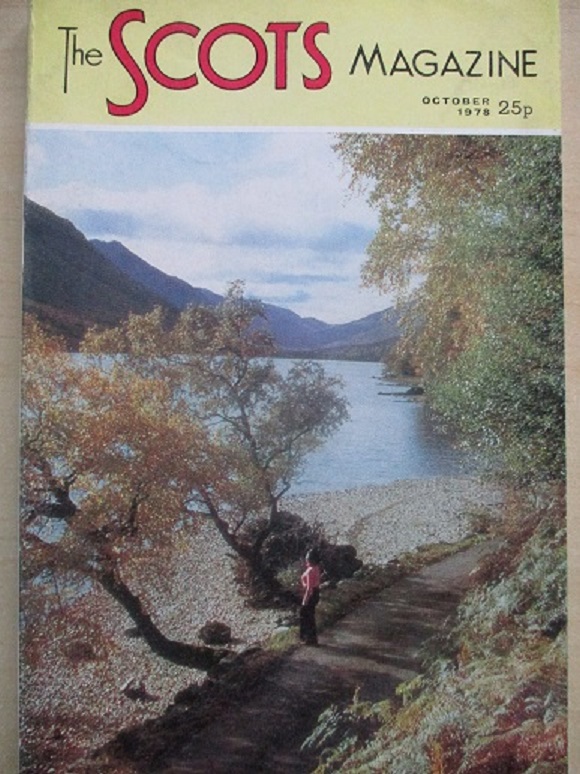Magazine Review: The Scots Magazine October 1978
Like many people of Scots descent, I have a mild interest in the country and customs of my ancestors. I even wonder sometimes what the place is currently like. For me and people like me, there’s the regional interest publication, The Scots Magazine. First published in 1739 as a more general magazine that happened to come out in Scotland, it’s gone through some name changes and periods of non-publication, but is now the world’s oldest magazine in current publication. A family member stumbled across this vintage issue and shared it with me.

The issue opens with an editorial comment discussing Dutch Elm Disease and farmers chopping down border trees to expand their fields, which between them were making for some treeless views in the countryside. The unnamed editor wonders if it will be necessary to pay farmers to keep some trees planted.
The first of two Letters to the Editor sections includes missives trying to track down a vaguely remembered tree, considering the possibility of reincarnation, and quoting minor Scots poets.
“The Castle of Mey” by Hubert Fenwick talks about the fortification formerly known as Barrogill Castle, in Caithness on the northern end of Scotland. At the time of writing, it was primarily used as a holiday residence by the Queen Mother, who’d bought and had it refurbished in 1952 after the death of King George VI. There are some nice sketches of the exterior, and a couple of interior photographs.
“France Shows the Way”, an opinion piece by John MacLennan, talks about how the French have been better at preserving historic buildings than the Scots in their small towns. Also, he’s anti-parking meters and pro-local bakeries.
“Ye Amphibious Ancients” by David Phillips traces the history of a swimming club on the River Tay, near Dundee, from 1884 to the then present. The big activity for the club was crossing the wide river, and for the serious swimmer, going both ways.
“From the New Books” is quick reviews of several books, most of direct Scottish interest, The Scottish Novel, A Scottish Bestiary, like that. The odd one out is Everest, Goddess of the Wind, apparently included as some Scots had attempted the climb.
“The Yachting” by Sutherland Manson talks about model boat competitions on the island of Stroma off the north coast of Scotland. (The island is now uninhabited.)
“Growing Old” by Douglas Fraser is a nice poem about a mountain climber enjoying the sight of young people tackling the steep hills and mountains he did in his youth. Nostalgic.
“Footlights at the Abbey” by I.A.N. Henderson details the history of the Abbey Theatre of Arbroath (on the North Sea coast not far from Dundee), a local community theater at that time housed in a former hackle shop.
“Raise the Gitana!” by John Rundle was about the attempt to recover a ship that had sunk in Loch Rannoch (which is in Perth and Kinross) back in 1882. The Gitana had been meant as a ferryboat, but local landowners objected to the building of a pier on the opposite end of the loch, so its few months were as a luxury fishing boat for its wealthy owner until the winter storms revealed a weakness in its construction.
Most notable bit: after six years of public planning, with only a week to go before the attempt, suddenly the leader of the diving team gets a visitor from “interested parties” suggesting that the raising should not be done. This is never explained, and the attempt goes on without any mysterious deaths.
Tom Weir’s column “My Month” is this time about visiting the deserted island of Heisker in the Monachs (visited by lobster fishermen who kept the old schoolhouse fixed up as a shelter), then the Broadcairn highland near Dubh Loch. He’s quite the walker, it seems!
“Linwood–It’s Some Place!” by Marion Law details the history of the town in Renfrewshire (near Glasgow) which was then known for its Chrysler automobile factory. The title comes from an 1890 Kilbarchan joke, “If there’s a place that’s nae place, then it’s Linwood.” The author opines that the jokester would change his mind now! (Sadly, three years after this article, the factory closed and the town went into a spiral of unemployment it’s never fully recovered from.)
An interesting bit to me was that the police had much more power over the local government than was standard for Scotland at the time.
“A Quick Look…Around Scotland” is a collection of small news bits ranging from an amateur photography exhibit in Perth to a fund being organized in the name of a recently deceased birdwatcher.
“The Good Old Tattie” by Donald MacLean is a paen to local Scottish varieties of potato, written by a fellow trying to preserve as many heritage breeds as possible as the market turned to mass production of blander taters. Cute pictures of anthropomorphized potatoes according to their varietal names.
Finally, it’s time for more Letters to the Editor, most notably slightly different takes on the life and martyrdom of the Covenanter Captain John Paton, hanged for rebellion.
It’s an interesting collection of short pieces about places and activities in Scotland as seen in 1978, You may or may not be able to track down stray copies at garage sales, but large libraries may have collections that you can look at. Recommended to readers of Scots heritage and those with a fondness for Scotland as a concept.

